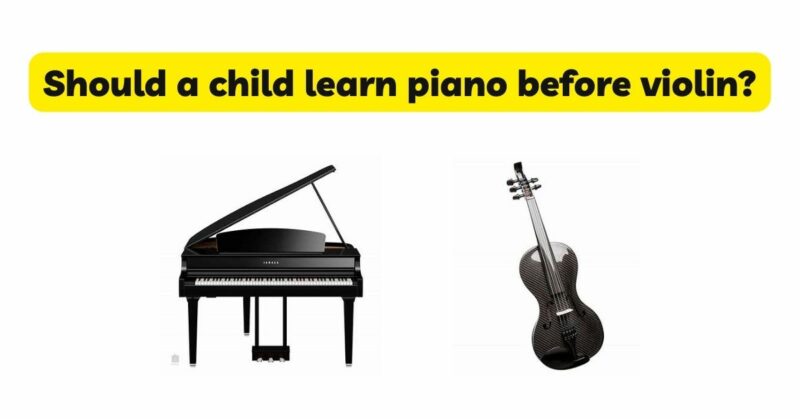When it comes to choosing the right instrument for a child’s musical education, the decision can be challenging for parents. Among the plethora of options, the piano and the violin often take center stage. While there is no definitive rule, many argue that learning the piano before venturing into the world of the violin can offer significant advantages. In this article, we will delve into the reasons why starting with the piano can lay a solid foundation for a child’s musical journey, ultimately enhancing their potential to excel in violin playing.
I. The Piano as a Stepping Stone to Musical Fundamentals
- Intuitive Learning of Music Theory: The piano’s layout provides a clear visual representation of musical concepts, such as scales, chords, and intervals. Each key corresponds to a specific pitch, making it easier for young learners to understand the relationship between notes. By grasping these fundamental elements, children develop a solid understanding of music theory, which can later be applied to any instrument, including the violin.
- Ear Training and Harmonic Awareness: Playing the piano involves both melody and harmony, allowing children to explore the interplay between different musical voices. By practicing chords and playing harmonies, young pianists develop their ear for musical nuances and learn to recognize harmonic progressions. This early exposure to harmony lays the groundwork for more advanced concepts in music composition and arrangement, giving future violinists a head start.
- Comprehensive Musical Expression: The piano’s vast range of notes and its ability to play multiple voices simultaneously enable young learners to experiment with dynamics, phrasing, and expression. By gaining proficiency in controlling tone, volume, and articulation, children acquire a versatile tool for musical storytelling. These expressive skills can be transferred to the violin, allowing future violinists to imbue their playing with emotion and nuance.
II. Technical Advantages and Physical Development
- Development of Hand Coordination: Learning to play the piano requires coordination between both hands, as they often perform different roles simultaneously. This enhances hand-eye coordination, fine motor skills, and finger dexterity. By training their hands to work independently, children develop the necessary coordination and muscle control that will be invaluable when transitioning to the violin’s more demanding technique.
- Finger Strength and Technique: The piano’s weighted keys provide resistance, requiring young pianists to develop finger strength and control. This physicality prepares the fingers for the demands of playing the violin, where precise finger placement, bowing techniques, and finger strength are crucial for producing a beautiful sound. The piano’s weighted keys also promote a disciplined approach to touch and dynamics, which can be applied to the nuanced art of violin bowing.
- Sight-Reading and Musical Literacy: Reading sheet music is an essential skill for any musician. The piano’s straightforward layout, with notes clearly laid out on the staff, facilitates the development of sight-reading abilities. By learning to read music on the piano, children become familiar with key signatures, rhythms, and musical symbols, making the transition to reading music for the violin less daunting. This advantage accelerates their progress in learning new pieces and interpreting musical notation.
III. Nurturing Discipline and Practice Habits
- Building a Strong Foundation: Learning the piano requires consistent practice and discipline, instilling in children a strong work ethic and the importance of regular routines. By mastering the piano’s technical challenges and dedicating themselves to daily practice, children develop perseverance and resilience, qualities that will benefit them in their pursuit of the violin.
- Cultivating a Musical Ear: Playing the piano helps refine a child’s musical ear as they listen to the harmonies, intervals, and melodic lines they create. This active listening cultivates a sense of pitch and aural sensitivity, which are essential skills for playing the violin. With a well-developed musical ear, children can better replicate melodies, understand intonation, and appreciate the nuances of tone production on the violin.
- Musical Exploration and Expression: The piano’s versatility allows children to explore various musical genres and styles, encouraging them to develop their unique musical preferences. This exploration helps broaden their musical horizons and exposes them to different compositions, which can inspire their creativity and inform their violin playing in the future. Additionally, the piano’s capability for independent accompaniment enables young pianists to experience the satisfaction of performing both melody and harmony, fostering a deeper understanding of musical structure.
Conclusion:
While there is no definitive answer as to whether a child should learn the piano before the violin, there are compelling reasons to consider this sequence. Starting with the piano provides a solid foundation in music theory, ear training, and technical skills. The piano’s intuitive layout, comprehensive musical expression, and the development of hand coordination prepare young musicians for the intricacies of the violin. Moreover, learning the piano nurtures discipline, practice habits, and a well-trained musical ear, all of which contribute to a child’s overall musical development.
Ultimately, the decision should be based on the child’s interests, preferences, and individual learning style. Regardless of the chosen sequence, a supportive and nurturing environment, along with dedicated practice, will be the key to a child’s success in both piano and violin. By giving children the opportunity to explore and excel in multiple instruments, we empower them to become well-rounded musicians with a deep appreciation for the art of music.


